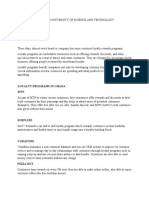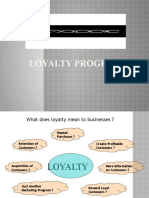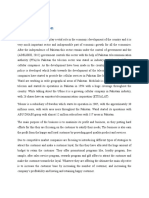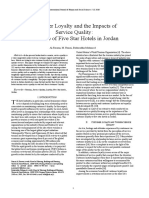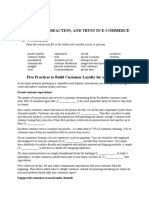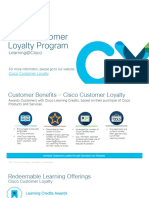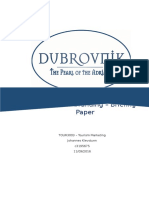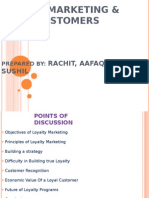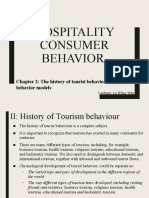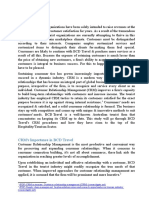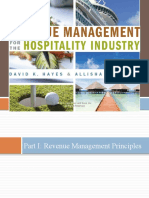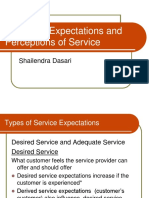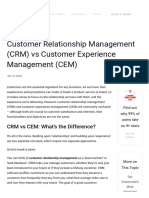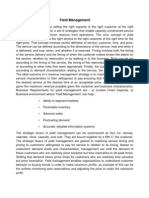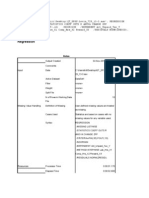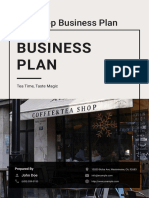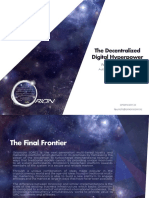Key Objectives of Customer Loyalty Programs & Examples of Customer Loyalty Programs
Key Objectives of Customer Loyalty Programs All the customer loyalty programs have a unified objective and they all stress on a single important aspect in customer management, that is, it is cheaper to market to existing customers than to acquire new ones. The key objectives of introducing customer loyalty programs can be however be further breakdown into four different categories as below: Building true loyalty: This refers to building a greater commitment to the product or organization through the building of true loyalty, both in attitudinal and behavioral terms. However, the consequences of true loyalty- greater commitment, greater word of mouth (WOM)- are difficult to measure. This objective is not easy to achieve because consumers can be fickle and economic benefits are important to them. Hence, building true loyalty is the goal of many loyalty programs. Efficiency Profits: This refers to immense profit consequences as compared to profit consequences without loyalty programs. A loyalty program attracts more customers to make frequent purchases at one place only for their needs which helps in capturing more profits from them in turn. Effectiveness profits: They are long-term profit consequences realized through better knowledge of customer preferences over time. This allows sustainable value creation for customers. Value Alignment: The goal is to align the cost of serving a particular customer with the value he or she brings to the firm. This enables a firm to serve its customers in best manner.
�LOYALTY PROGRAM EXAMPLES.
1. HOTEL INDUSTRY For free nights, some of the most generous programs aren't based on points and aren't tied to any hotels. Instead, they're available at discount travel sites, like Hotels.com, which gives a free-night voucher to rewards members who book 10 nights through its site. Hotel guests receive a credit equal to the average amount of money they spent on previous hotel stays, and they can use it at more than 65,000 hotels. But choose a room that costs less than the credit and the remaining credit amount is lost. At the same time, many hotel rewards programs are also extending their reach to include properties with different price ranges in many countries: InterContinental's program includes Crowne Plaza and Holiday Inn. Members who spend at least $1,000 can get a free night; that's the lowest of all major hotel chains, says Hlavinka. For consumers who travel mostly within the U.S., Stash Hotel Rewards launched last year and members can earn a free room with at least 3,800 points, or $760. Around 120 independent hotels participate in the program. That's not many there's no participating hotel in Las Vegas, for example, or Dallas or Philadelphia -- though the company says it's expanding its offering, says a spokeswoman. Casinos are now expanding their rewards programs too -- guests are more inclined to spend money playing poker if they can end up with a free room, says Hlavinka. The most generous allow players to receive points for all gaming not just slots and to redeem on expenses including rooms, dining and entertainment. MGM M Life players club, which launched in January, offers these options in Las Vegas, Detroit and Biloxi, Miss. points earned at one casino are transferrable to other locations. And Harrah's Total Rewards is used in casinos in about a dozen U.S. cities and abroad. The programs are free to participate, but the cost may still be too steep for some: They require gambling, which comes with its own risks.
�2. CLOTHES AND SHOES Walk up to a register at most retail stores and chances are a salesperson will pitch the company's loyalty program. Retail rewards account for 40% of all loyalty memberships, up from about 29% just two years ago, according to Colloquy. More companies are promoting them to customers as they face competition from discounters, says Hlavinka. The best programs for consumers are roughly equal to a steady 5% to 15% discount. At shoe retailer DSW, customers get a $10 certificate for every $150 spent on regular-priced merchandise. At women's retailer Chico's, it's a 5% discount after spending $500. At Chico's, 90% of sales come from customers in the loyalty program though Robert Atkinson, vice president of investor relations says its objective isn't to make them spend more than they intend. And while higher-end retailers often reward loyal customers in other ways, offering sneak peeks at new collections for example, Bloomingdales and Saks Fifth Avenue roll out seasonal rewards programs that give shoppers store gift cards for every few hundred spent. At Saks shoppers could earn $450 for $3,000 of purchases equal to 15% cash back. (Some high-end brands, like Chanel for example, are excluded.) 3. GAS With gas prices up 13% in the past month, consumers won't find the most generous rewards at gas stations. Instead, supermarkets that sell gas tend to offer the best deals for frequent customers. Those who use the store's loyalty card free to sign up for -- earn points for in-store purchases that can be used for a discount on gas. At Kroger, drivers could get up to 40 cents off per gallon; Giant Eagle and Safeway offer up to 10 cents off the gallon. On a 25gallon fill-up, that could be a $10 savings. Still, these programs can kill a consumer's instinct to comparison shop, which means they could end up paying more for grocery items that could be found cheaper elsewhere just to earn the points for discounted gas.
�Aside from supermarkets, loyalty programs that help consumers save at the pump are limited to credit cards. The most rewarding are pegged to specific gasoline brands, according to CardHub.com. Cards from Shell and BP offer 5% rebates or 20 cents off gas at $4 per gallon. Drivers who aren't loyal to a gas brand might consider Capital One's No Hassle cash rewards card, which offers 2% cash back for gas purchases at any station. Credit card issuers can offer these rewards because gas stations pay larger interchange fees than other retailers, says Odysseas Papadimitriou, CEO of CardHub.com. But consumer advocates encourage consumers to be especially careful with these cards. The interest rates can be up to 24% -- which will eat away at that gas savings if you carry a balance. One strategy: Swipe for gas only, and pay the balance in full each month. 4.BANKING Even banks have gotten into the rewards game, offering consumers cashback for debit card use for now. There's no telling how much longer these programs will exist. Many banks have cut back on rewards and more could follow, says Greg McBride, senior financial analyst at Bankrate.com. That's partly because the Durbin amendment to the financial reform bill goes into effect in July and limits how much banks can earn when shoppers use debit cards. Already in February, Chase, whose 3% cash-back debit card was one of the more generous options, closed the program to new customers. For now, the best rewards are 2% cash back for debit-card purchases, though there are often conditions attached. Online bank PerkStreet Financial offers that rate, but only for non-PIN swipes and a $5,000 minimum balance in a 0% interest account. To break even, debit-card users would have to swipe for $250 of purchases each month to earn about the same if they left $5,000 in a high-yield savings account at today's rates. (The bank offers 1% cash-back for customers with lower balances.) In lieu of cash rewards, other companies give by not taking, eliminating ATM fees. Customers with a checking account at Charles Schwab or Fidelity get
�reimbursed for fees charged by ATMs, which could be as much as $230 a year, according to calculations based on data from the TowerGroup. But if customers overdraw, the company might take the amount of the overdraft from cash or money market mutual funds in their brokerage account. 5. HEALTH CARE Consumers on average pay $29 in co-pays for each prescription, according to the Kaiser Family Foundation. That's up 76% over the last decade, and rising, experts say. That money should get you something, and in limited instances it can: at Rite Aid and CVS, members of the stores' loyalty programs earn points for all purchases including prescriptions, which can then be applied to discounts on non-prescription goods. (Other drugstores exclude prescriptions from their in-store loyalty programs.) At Rite Aid, customers can qualify for free cholesterol and glucose screenings. Health-related rewards programs are also growing among employers. About 43% of employers with at least 10,000 employees offer incentives including lower premiums -- to employees who participate in weight loss programs, smoking cessation initiatives or other health programs, according to human resources consulting firm Mercer. That's up 7% since 2009. And consumers who've purchased private health insurance policies can get discounts on gym memberships, weight loss programs and even yoga classes, says Russell Robbins, a senior clinical consultant for Mercer. Aetna and Cigna offer policyholders up to 30% off Jenny Craig, NutriSystem and some health books. 6. Retail Industry Today retail industry in India has to offer more to its customers as compared to any other industry or sector. With the growth in organized retail in India and increase in the number of customers footfalls the competition is increasing on a daily basis. Retailers like Big Bazaar and Pantaloons are trying to increase their market share and capture and retain more and more number of customers. To increase customer loyalty retailers like Big Bazaar has come out with a scheme of Payback Card offering through which customers can
�redeem their purchase points. It is offering its T24 simcard to its customers in which they gain a free talk-time of Rs. 15 on purchases of above Rs. 500, Rs. 35 on purchases of above Rs. 1000 and so on, which they can recharge on the spot. Pantaloons is also offering a Greencard scheme to its customers using which after a purchase of Rs. 8000 they can get a discount of 3% on their next purchase. 7. e-tailing Today e-retailers like myntra.com has also come up with exclusive customer loyalty programs like giving free coupons to customers on each of their purchases which can be redeemed by customers to get discount on their next purchase. All such customer loyalty programs attract customers to purchase one more time to redeem their free coupon discount which they get on each time of their purchase thus making them more loyal to visit such sites.
_______________X________________

